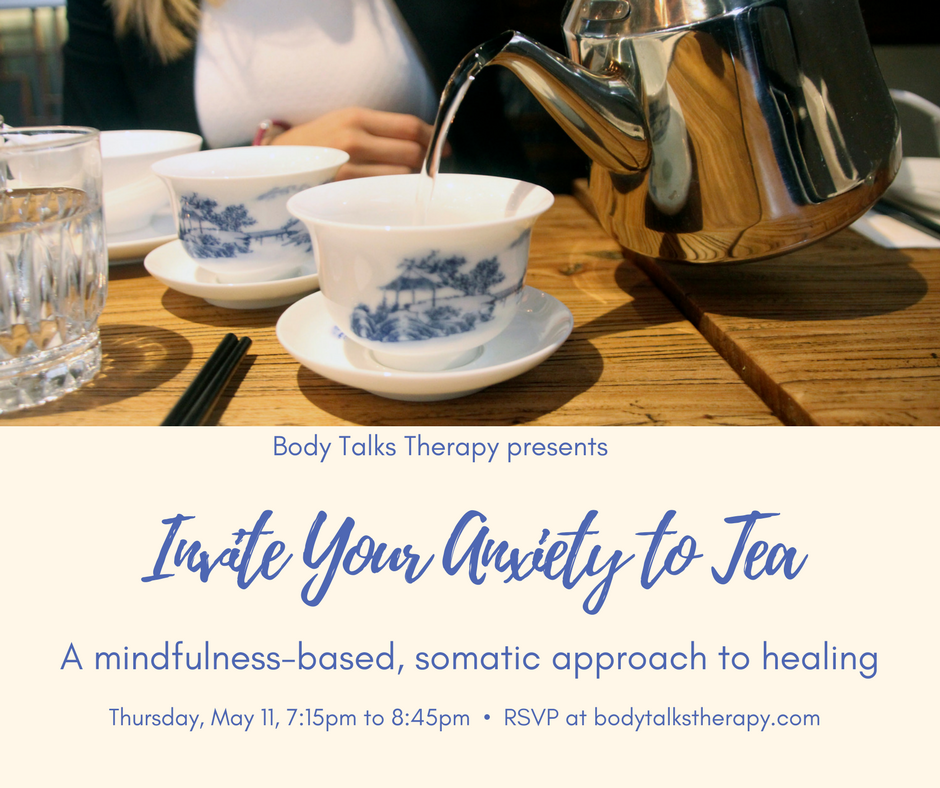Much of this article by Allison Brunner, LCSW, is reprinted from Natural Awakenings magazine’s (Lancaster/Berks edition) November 2016 issue.
Many of us know it well: a gnawing in the pit of the stomach, an ache in the chest, shallow breathing, rapid heartbeat or a lump in the throat. Roughly 40 million Americans (or 18 percent of the population above the age of 18), according to the Anxiety and Depression Association of America, experience anxiety as a full-blown disorder.
Most of us encounter the symptoms from time to time. Hardwired to avoid pain, we do everything we can to self-distract or problem-solve our way out. We try to convince ourselves we’re “worrying about nothing”. In cognitive approaches to psychotherapy, too, we examine the validity of the thoughts that create suffering and attempt to assuage our fears by labeling them irrational.
But how effective has that been for you?
Running and thinking (or arguing with our thoughts) exacerbate angst. The worse we feel, the more afraid we tend to become, wondering how long the discomfort will last or whether it may worsen and turn us crazy. Our minds are adept at tricking us into believing that what’s really a mouse in the closet is a six-foot monster with fangs.
What if we tuned into our bodies when the symptoms, like little lights on an automobile dashboard, indicated distress? What if we pulled up a chair and invited our anxiety to tea, so to speak? When we take the opportunity to face it, feel it and get to know it a little better, it calms. We can drop beneath it and find that where it was trying to turn our attention is an emotion that is far more tolerable than panic or fear. There may be sadness, grief, disappointment or anger—only a mouse when compared to the anxiety monster.
Try the following next time the body-mind gets noisy.
Find a safe, quiet space where you can turn your attention inward. It’s best to sit on the floor and allow yourself to feel the support of the earth beneath you. Squeeze all of the breath out of your belly, if you can; then fill it first, before your lungs, with fresh air. Notice whether your body is holding tension and relax if you’d like.
Let go of thinking. There is no future, not even a few minutes from now. There is only this moment. Breathe.
Enhance your feeling of safety by focusing on an object in the room that gives you pleasure. Notice the quality of light where you’re seated. Feel the texture of your clothing against your skin. Notice any sounds, smells, the taste in your mouth.
Where in your body are you feeling anxious? What are the physical sensations that accompany it? Place your awareness in that area. How much space does it take up? Does it have a shape; is it solid or diffuse; does it have a temperature?
Stay out of story. Remove the labels (good, bad, awful, terrified) from what you’re feeling. Simply allow yourself to feel what you feel.
What does your body want to do? Does it want to curl into a ball while wrapped in blankets? Do you need to cry into a pillow or scream? Do you need to shake, punch or kick? Allow the release.
Emotions move like waves; they don’t last forever. Give yourself 15 to 30 minutes to ride this one, rather than being pummeled by it, and know that the nervous system will calm again. When we resist, anxiety persists and either somaticizes or intensifies.
Once the waters still, ask your body what it needs. Reconnect to your five senses and where you’re situated in time and space. Soothe yourself with a warm bath, lit candles, low lights or relaxing music. Make yourself a warm cup of tea. After you’ve braved this storm, those in the future will feel more manageable.

Body Talks Therapy owner, coach, healer, and facilitator of a community of Highly Sensitive People, Allison Brunner, LCSW, will facilitate a workshop on Thursday, May 11, 7:15pm to 8:45pm, at Mulberry Art Studios’ Mulberry on King, 253 W. King St., Lancaster (off-street parking is available against the side of the building, near the entrance. Join us for a combination of psychoeducation, hands-on learning, and experiential practice of tools for coping with and minimizing or even eliminating your symptoms of anxiety as a way of protecting yourself against the emotions that scare you.
Bring a pen and paper or journal. If you prefer to express yourself through art or music, bring the tools to do so. We’ll engage in body awareness and somatic work (grounding and resourcing), mindfulness practice and strategies, guided visualization, “parts work,” and journaling.
RSVP and pay here in advance. For questions, contact info@bodytalkstherapy.com.
— Allison Brunner, LSCW, RM, Body Talks Therapy


